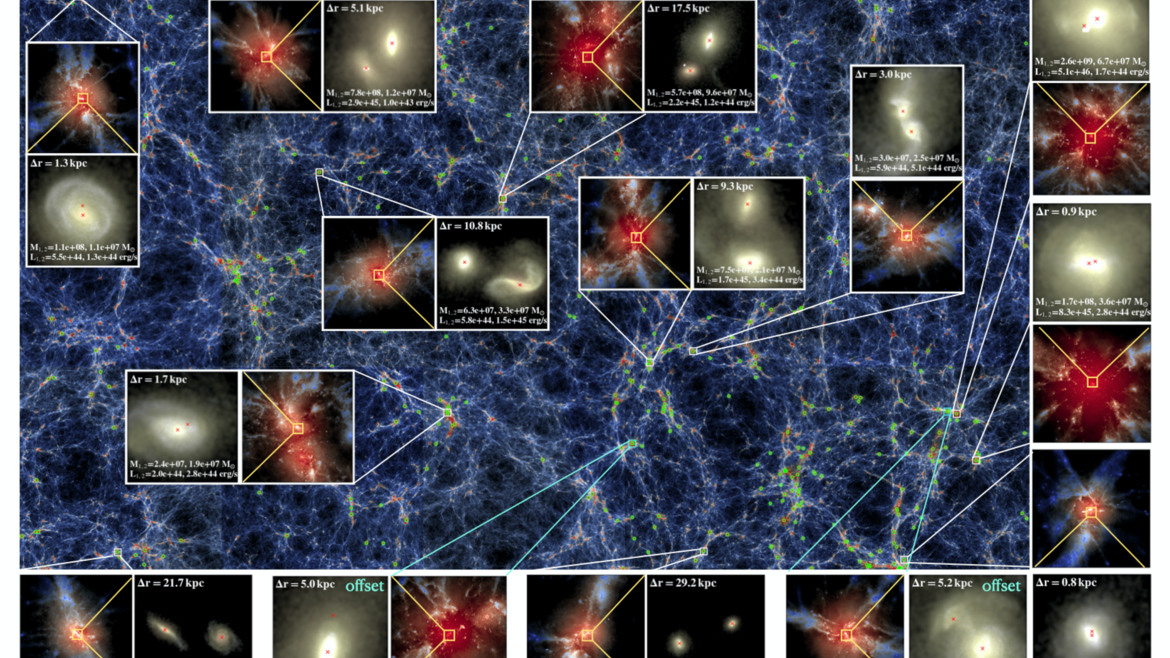The astronomy group at UC Riverside has eight astronomy faculty members, ~5 postdocs, and ~25 graduate students. The group is extremely strong in extragalactic astronomy, with three theorists and five observers. Below is a summary of the various research topics.
Cosmological Simulations and Machine Learning
UCR astronomers are playing a pivotal role in advancing the field of cosmological simulations through cutting-edge projects such as the ASTRID simulation. With a particular focus on high redshift galaxy formation and black hole mergers, ASTRID represents the largest simulation to have ever reached z=1. We are also utilizing the power of machine learning to enhance simulations in innovative ways. This includes the ability to create simulations at higher resolution than was previously thought possible.
Simulations of the Intergalactic Medium: Our latest project involves a suite of simulations of the gas in the intergalactic medium. We have used machine learning to interpolate between these simulations. Through careful comparison with real-world observations, we can constrain the parameters of cosmology and deepen our understanding of the origins of the Universe.
Galaxy Evolution
Cosmic Dawn and Reionization
Galaxies began to form rapidly within the first billion years, with profound consequences on the intergalactic medium. Several groups at UC Riverside are involved in the largest surveys ever conducted with the Hubble and Spitzer Space Telescope and the Keck Observatory. We are determining how quickly star formation began and how this star formation ionized all of the hydrogen in the intergalactic medium.
A Census of Star Formation
Most of the stars in the universe formed 7-11 billion years ago. We are quantifying the global rate of star formation at this critical epoch, and understanding where and why the star formation happened.
Dust Extinction and the Infrared Background
Much of the light we observe from distant galaxies has been absorbed by dust within those galaxies. With ultraviolet and infrared measurements from the ground and in space, we are determining how to correct for the absorption to better determine the intrinsic properties of galaxies.
As the dust absorbs light, it heats up and emits infrared radiation. Fully one half of all light from galaxies is emitted in the infrared. With the Spitzer and Herschel Space Telescopes, we are measuring galaxies’ infrared luminosity to better understand their star formation and black hole accretion rates.
Galaxy Clusters and Cosmology
Galaxy Formation in High Density Environments
Rich Clusters as Lenses
The extreme gravitation fields of galaxy clusters can bend light from background galaxies, acting as magnifying glasses for us. Because of this we’re able to see fainter galaxies than would otherwise be possible. We are using these natural magnifying glasses to study, in exquisite detail, the properties of extremely faint galaxies in the distant universe.
Active Galaxies
Black Hole Growth in the Early Universe
Recent discoveries suggest that very massive (billion solar mass) black holes were able to form in the early universe. Several groups at UCR are conducting searches for black holes that are actively growing during these early epochs. The number of these black holes, and their spatial distribution has profound effects on galaxy formation and the temperature and ionization state of the intergalactic medium.
Accretion Triggers and the Starburst/AGN Connection
The mass of a galaxy’s central black hole is correlated with the mass of the galaxy, though their sizes are dramatically different in scale. It begs the question, what triggers star formation and what triggers black hole growth and are they related? We are studying the properties of galaxies with and without black hole accretion, and with and without star formation, to better understand the mechanisms which trigger these processes, and how tightly they’re related.
AGN Feedback
Actively accreting black holes expel enormous amounts of light and mechanical energy. We are investigating the effects of this energy on the surrounding galaxy and beyond.
Planetary Science
Planetary Habitability
UCR astronomers examine a diverse range of topics regarding exoplanets and planetary science. A primary research focus is planetary habitability, the evolution of terrestrial planets, and the divergence of Venus and Earth. Prof. Kane is a science team member of DAVINCI; a NASA Discovery mission that will measure the temperature, pressure, composition, and chemistry profile of the Venusian atmosphere. His research also includes the discovery of exoplanets using a variety of detection techniques, planetary orbits and dynamics, and the atmospheres of Uranus and Neptune.

Planetary Science and Astrobiology
Prof. Schwieterman is an interdisciplinary scientist with broad interests in planetary science and astrobiology. His research includes climate, photochemical, and spectral modeling of terrestrial planet atmospheres, including the connection between the (bio)geosphere and atmosphere. He's particularly interested in work that can inform our ability to characterize Earth-sized planets in the habitable zones of their host stars, especially in search of remotely detectable biosignatures. His work often lies at the intersection of geosciences, biology, and astrophysics.


